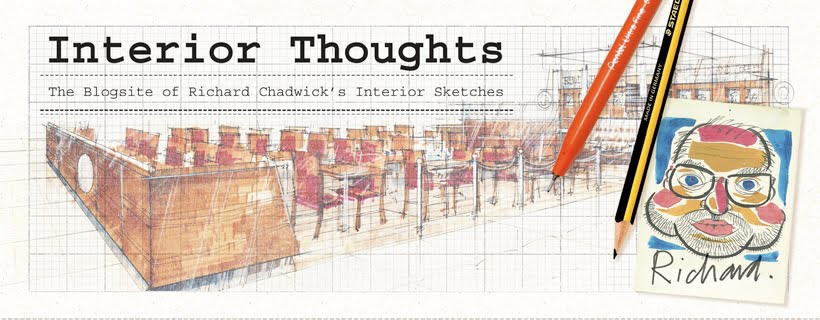Architecture - architectural spaces - in films have always interested me , from the dystopian future visions of Alphaville and Blade Runner via the wonderful madness of ' Schenectady, New York ' - the sheer conceit of building a full scale 1:1 replica of New York ( shades of Luis Borges ) - to the more arcane mysteries of space in Cube and Fermat's Room .
The all pervasive use of CGI has now rendered the nightmarish vision of even full cityscapes peeling back and dissolving commonplace - viz Inception - but personally I prefer the more more surreal visions of space as viewed in such films as ' Last Year in Marienbad ' , when you suddenly realise that the never-ending panorama of adjacent endless corridors illustrated as the camera pans across the interiors can't possibly exist physically together as shown in the film.....and ' The Cabinet of Dr Caligari ' is still one of the best examples of German Expressionism , where the distorted perspective perfectly matches the distorted view of reality as portrayed in the film.
Do film spaces exist in real time, do directors consider the flow of space from an architectural , theatrical , psychological perspective ?
Do film spaces exist in real time, do directors consider the flow of space from an architectural , theatrical , psychological perspective ?
Published in conjunction with the exhibition ' The Wrong House ' in Antwerp in 2007 , also curated by Steve Jacobs , the book analyses Hitchcock's films in terms of the sets and how these re-inforce the theme of the film.

Architectural reconstructions of alternative spaces are reasonably common occurances with regard to the analysis and understanding of paintings ; the interiors of Vermeer , the ' Flagellation ' by Piero della Francesca , both with single fixed points of view , lend themselves readily to a reconstruction to establish the point of view of the spectator . Rembrandt's ' Night Watch ' and Massacio's ' Holy Trinity ' , amongst others, have been subject to further discussion and conjecture with regard to the spacial dynamics of the paintings , and the relationship between the viewer and the painted space , particularly with regard to Massacio's fresco and the suggestion of a barrel-vaulted space existing in real time. This book however is the first time that I have come across cinematic spaces analysed in such a fashion.
Hitchcock took great pains to establish real time spaces in which to set his films , and the book establishes the sets as of fundamental importance in creating and underpining the themes. The set for ' Rear Window ' was at that time the largest indoor set ever built at Paramount and was constructed - over six weeks - to solid architectural principles in that fire escapes , drainage systems etc were all workable . The set for ' Phsycho ' re-inforces the schizoid nature of the film , the solid logical contemporary layout of the motel acting as counterpoint to the gothic unknown spaces of the Bates house looming over it - apollonian v. dionysian .
I think what fascinates me here is the idea that ' architecture ' , the creation of buildings and by definition a series of internal spaces , doesn't necessarily have to exist purely in ' built ' form , and that some of the more creative and thought-provoking concepts exist away from a formaly constructed state .
Anyway , an absorbing book that certainly enhances the viewing of Hitchcock's films.




No comments:
Post a Comment